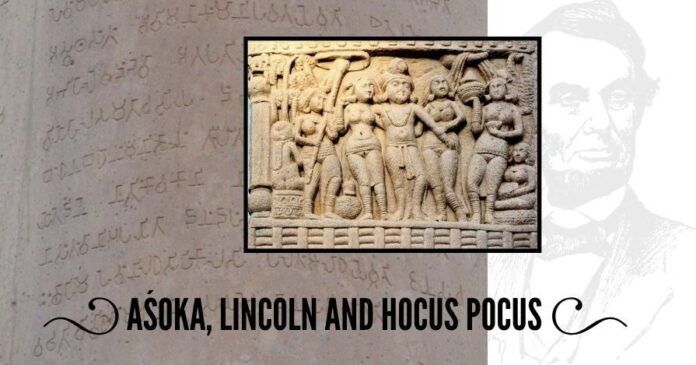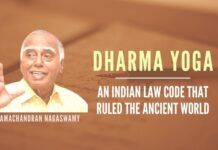
The mystery is whether Aśoka’s declaration was the inspiration for Wycliffe (and Lincoln) through intermediary story-tellers who took the phrase from India to Europe? Or is it just a coincidence?
Are there universal patterns of human behaviour and, equivalently, are there universal ways humans express certain ideas? The answer to this question will be “yes” if there is a universal grammar that encodes a genetic component of language leading to structural rules that are independent of sensory experience, and Bhartṛhari’s padasphoṭa and vākyasphoṭa may represent such universals. But the positive answer will not stand if cultural diffusion between cultures under study cannot be ruled out.
Let’s begin with the story of The Indian Emperor Aśoka (ruled 268–232 BCE). He ordered more than thirty inscriptions about his reign on pillars, boulders and cave walls and most of these are in the Brāhmī script. These inscriptions are dispersed throughout the areas of modern-day Bangladesh, India, Nepal, Afghanistan and Pakistan, which shows the broad extent of his rule.
it is almost certain that both Webster and Lincoln had borrowed this phrase from John Wycliffe (14th century), the first translator of Latin Bible to English who says in the prologue of the translation: This Bible is for the Government of the People, by the People, and for the People.
I have had the opportunity to visit the edict at Kālsī, which is one of the few to be found in north India. It is unique in that it is near the remains of an altar constructed for a royal Aśvamedha rite performed in the third century. Situated at the confluence of Yamuna and Tons rivers, beyond it to the west lies Himachal Pradesh. Tons is the larger river at the join, and many have theorized that it is the Vedic Sarasvati which, in ancient times, flowed parallel to the Yamuna, meeting it much further down in Haryana.

The Kālsī edict is inscribed on quartz rock which is 10 feet high, 10 feet wide, and 8 feet deep at its base. Like most other edicts, it is in Prakrit, written in Brāhmī script, and it appears to have been issued somewhat before 250 BCE. It describes Aśoka’s policies, reforms and injunctions for good citizenship. The prescriptions mentioned include self-control, purity of mind, gratitude, service to parents and ascetics, alms to brahmins and śramaṇas, proper behaviour towards friends, relatives, and servants, and concordance in religious matters. The edict also speaks of the lands in the south and the west where Aśoka has sent his embassies to spread the message of dharma.
With this background let’s look at a literary mystery regarding another of Aśoka’s inscriptions. He concludes the Delhi-Topra Rock Edict with the declaration:
esa hi vidhi ya iyam:
dhammena pālanā, dhammena vidhāne,
dhammena sukhiyanā, dhammena gotī ti
The word dhamma (or dharma) is usually translated as law or truth, or sometimes it is left untranslated. If we choose the common meaning, law, Aśoka’s declaration becomes:
For this is my rule:
governance by the law, rule of the law;
prosperity by the law, protection by the law.

Let’s advance 2,100 years and consider Abraham Lincoln. He concludes the Gettysburg Address with a flourish similar to Aśoka’s: “government of the people, by the people, and for the people.”
Many don’t know that Lincoln was echoing Daniel Webster’s 33-year old speech in the Senate where he spoke of the “people’s government, made for the people, made by the people, and answerable to the people.”
But it is almost certain that both Webster and Lincoln had borrowed this phrase from John Wycliffe (14th century), the first translator of Latin Bible to English who says in the prologue of the translation:
This Bible is for the Government of the People, by the People, and for the People.
The mystery is whether Aśoka’s declaration was the inspiration for Wycliffe (and Lincoln) through intermediary story-tellers who took the phrase from India to Europe? Or does the common element merely represents the working of the universal grammar in our minds?
Some scholars argue that the Pañcatantra and the Jātaka stories from India have influenced nearly fifty per cent of all European nursery rhymes and ballads. Even nursery rhymes with nonsense words have travelled.
Stories from India to Europe
We know of the transmission of stories westward from India as in the Pañcatantra, पञ्चतन्त्र, translated to Kalilah wa-Dimnah in Arabic (after the names of the two jackals Karakaṭa and Damanaka) and into various European languages thereafter. These stories as well those from the Kathā-Sarita-Sāgara became part of the Arabian Nights and Sindbad. Scholars have also noted parallels between the Pañcatantra and Aesop’s fables.
For another explicit example from Europe, note the Christian legend of Barlaam and Josaphat (Bhagavān and Bodhisattva) which was a reworking of the story of Buddha’s enlightenment. The original story was a Mahāyāna text that was translated into Arabic and European languages.
The legend tells how an Indian king persecutes his own son, Josaphat, who astrologers have foretold will establish the Christian Church. In due course, Josaphat meets the hermit Saint Barlaam and converts to Christianity. In the end, the prince’s father accepts the son’s conversion and retires to the desert to spend his last days with the old teacher. The legend became so popular in Europe that, from time to time, the Church announced that their relics had appeared miraculously and these were then installed with solemn ceremony. Barlaam and Josaphat were elevated to sainthood by Orthodox Eastern and Greek churches.
According to 1911 Encyclopædia Britannica, “Their names were inserted by Petrus de Natalibus in his Catalogus Sanctorum (c. 1380), and Cardinal Baronius included them in the official Martyrologium authorized by Sixtus V. (1585–1590) under the date of the 27th of November. In the Orthodox Eastern Church “the holy Josaph, son of Abener, king of India” is allotted the 26th of August.”
Nursery rhymes
Some scholars argue that the Pañcatantra and the Jātaka stories from India have influenced nearly fifty per cent of all European nursery rhymes and ballads. Even nursery rhymes with nonsense words have travelled. Consider
Eenie, meenie, miney, moe/catch a tiger by the toe
If he hollers let him go/eenie, meenie, miney moe
This appears in English for the first time in the 19th century. In Germany, where it was known earlier, it has the form
Ene mene miste/Es rappelt in der Kiste
Ene mene meck/Und Du bist weg
Some claim that the original is the fifteen-hundred-year-old Sanskrit mantra (where words do not necessarily have meaning)
Ene mene dasphe/danda dasphe…
Of course, there has also been copying back to Hindi films as in
Ina mina dika/daye dame nika/maka naka naka and akkara bakkar bambai bo/eena meena mo.
Hocus Pocus or Hukus Bukus?
Could hocus pocus, used as an exclamation by magicians, have an Indian connection? According to some etymologists, it is played on the sacramental blessing from the Mass, Hoc est corpus meum (this is my body); another theory derives it from the Latin hicce es doctus (here is the learned man).
But there are exactly the same words hukus bukus in Kashmir, which are older and used as a magical formula. The Kashmiri rhyme begins thus:
hukus bukus, telli wann che kus
onum batta lodum degi,
shaal kich kich waangano,
brahmi charas puane chhokum,
brahmish batanye tekhis tyakha
The meaning is:
Who is he, who am I, then tell me who are you?
I got rice and put it in pot,
my breath goes in the center
I sprinkled water at my brow,
I am That, like a ṭīkā on my ṭīkā.
The rhyme has deep spiritual meaning in the philosophy of Kashmir Śaivism, which is a version of Vedānta that takes the universe as an embodiment of Consciousness. It begins with the perennial question of who one is and then speaks of rice and pot regarding the body and its needs, and then the breath that is the life force, and the counter-intuitive interaction of matter (water) with the breath. Finally, it is all tied together with a flourish in reference to the water-ṭīkā above the original one that marks physical beauty.
Acknowledgement: I am thankful to Rajesh Raina for his comments on my earlier interpretation of the hukus bukus rhyme.
Note:
1. Text in Blue points to additional data on the topic.
2. The views expressed here are those of the author and do not necessarily represent or reflect the views of PGurus.
- A Very Brief History of Indian Science - March 20, 2020
- Indian Foundations of Modern Science - March 16, 2020
- An Indian Classics Curriculum - December 31, 2019











Dear Subhash, I greatly admire your work and follow you on twitter. EVERYTHING western has origin in Ancient Bharat. This may sound little funny and sort of obsessive, but all can be proved if we do some research on our ‘granthas’. The origin of words in English have been taken as Latin by obviously western linguists, without anyone challenging or questioning them – as in modern times linguistic department has been largely dominated by them. However, close look at some words, we can easily decipher the inherent flaws in their practices.
For Example, even for toddler, it will be clear the word Hu-man has word Manu in it, reasoning clearly from vedas, Manu is the first person and we all came from him. Hu-Manu, the letter ‘u’ was somehow swallowed to make it look alien many be. Since western indologists/linguists had conveniently called Indian puranas and granthas as mere myth, it was very convenient for them to ignore and avoid even such a blatant obvious connections , so they can prove western superiority over the east! This is just a tip of iceberg!
Regards, Vikram